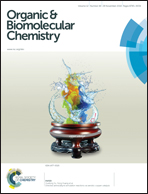The design, synthesis and biological evaluation of novel thiamin diphosphate analog inhibitors against the pyruvate dehydrogenase multienzyme complex E1 from Escherichia coli†
Abstract
Pyruvate dehydrogenase multienzyme complex E1 (PDHc E1) is a potential target enzyme when looking for inhibitors to combat microbial disease. In this study, we designed and synthesized a series of novel thiamin diphosphate (ThDP) analogs with triazole ring and oxime ether moieties as potential inhibitors of PDHc E1. Their inhibitory activities against PDHc E1 were examined both in vitro and in vivo. Most of the tested compounds exhibited moderate inhibitory activities against PDHc E1 (IC50 = 6.1–75.5 μM). The potent inhibitors 4g, 4h and 4j, had strong inhibitory activities with IC50 values of 6.7, 6.9 and 6.1 μM against PDHc E1 in vitro and with inhibition rates of 35%, 50% and 33% at 100 μg mL−1 against Gibberella zeae in vivo, respectively. The binding mode of 4j to PDHc E1 was analyzed by a molecular docking method. Furthermore, the possible interactions of the important residues of PDHc E1 with compound 4j were examined by site-directed mutagenesis, enzymatic assays and spectral fluorescence studies. The theoretical and experimental results are in good agreement and suggest that compound 4j could be used as a lead compound for further optimization, and may have potential as a new microbicide.


 Please wait while we load your content...
Please wait while we load your content...